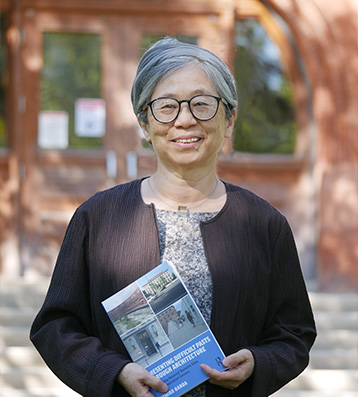Relevant to today’s designers grappling with the past, Handa publishes book exploring design strategies used in post-war Germany
September 14, 2021

How does one tell the story of a time, place or a culture especially when the picture isn’t pretty? Professor Rumiko Handa’s most recent book published by Routledge, “Presenting Difficult Pasts Through Architecture: Converting National Socialist Sites to Documentation Centers,” explores ways to present the past through architectural design in meaningful ways when applied to preexisting buildings and places. Through four case studies in Nuremberg, Cologne, Berlin and Munich, Handa examines how these communities approached creating documentation centers to share the history of Germany’s national socialism and the holocaust with others for posterity.
Handa’s research is particularly relevant to today’s designers as they grapple with design challenges of their own when dealing with projects such as Civil War relics, post-invasion Iraq construction and many other historically significant sites.
“In every community, there is always a dark past that at some point must be dealt with,” said Handa. “And I think we are living in a time where we really need to question ourselves, and think carefully about what we do with these places and sites.”
Her book explores the various paths post-war communities in Germany took dealing with these sites and more recently the choices of designers and planners and how they presented the past through the creation of four different documentation centers on those sites. Some post-war communities chose to demolish former Nazi headquarters and buildings in an attempt to erase and negate the past, some restored the buildings to pre-war conditions and others chose to show the scars of the past.
In the four case studies presented in Handa’s book, the buildings in Berlin and Munich were demolished but remnants such as foundations and neighboring buildings remained. However, in Nuremberg and Cologne the buildings were undemolished. Each of these communities and their designers approached the creation of their documentation centers differently, each having their own unique circumstances and situations. Handa explores how each design team used architectural design to present the past in a meaningful way.
In her research, Handa saw four common design strategies that emerged from these case studies: formal characteristics, physical traces, designation and memento. For example, she classifies a formal characteristic design strategy as a design that focuses on a building’s time of origin by way of its formal characteristics. The second strategy is where a building may recall an otherwise neglected past by bearing its physical traces. The third is when a building design commemorates a particular event or individual by being designated to do so. The fourth is a memento design strategy, representing a building as a reminder of a past simply because an event took place there, even when there is no deliberate designation, formal characteristics, or material trace.
Handa wants the reader to see these cases and design strategies as something that they can consider applying to their own project as they examine the possibilities.
“I'm not so interested in the cases themselves, as I am interested in how the profession or discipline can apply the information presented in the book to real-life situations,” said Handa. “I'm not presenting anything as the right answer. Of course it depends on the case, it depends on the place, it depends on the particular history of the site.”
Handa hopes this book will at least start the discussion and be a historical resource as communities explore the different ways to present their difficult, complicated pasts.
Handa is a renowned scholar in architectural theory, history and design and is the author of other architectural books including “Allure of the Incomplete, Imperfect, and Impermanent: Designing and Appreciating Architecture as Nature” and “Conjuring the Real: The Role of Architecture in Eighteenth- and Nineteenth-Century Fiction.”